This past weekend was the first time my wife and I tackled landscaping, AKA “The Lawn”. Basically, that means stripping mulch from flower beds, then hitting the lawn with mechanical and chemical defibrillators, with the hope of shocking it into green before it dies from neglect. Leading the charge was a thirteen year old Craftsman garden tractor, a 26 HP Husqvarna in thin disguise, turning leaves into mulch, dethatching tangled roots, leaving a trail of aerator cores, and spraying toxic chemicals to keep nature… real. And so it goes, around and around and around navigating the flat lands and thrill riding the steep slopes
I know “new” gadgets and machines are a lot of fun, but that old tractor fires up without hesitation, pulls any load, sips gas, and always goes where it is pointed. In the summer it is the center of our landscaping effort. In the winter it clears after heavy snow storms with ease. The black duct tape that covers the splits in its seat only speak to the tractor’s personality. I feel the same way about firearms. I like the old designs with modern execution… like this Winchester Model 1892.
 Focus, focus, focus… The Winchester Model 1892
Focus, focus, focus… The Winchester Model 1892
The historical information presented within this article came from three credible reference books and Winchester.
John M. Browning – American Gunmaker
Browning & Gentry
Winchester – An American Legend
R.L. Wilson
The History of Winchester Firearm 1866 – 1992
Thomas Henshaw
The respective authors spent months and years, sifting through original records and historical documents, interviewing company personnel and associated experts, etc., publishing information that the rest of us can use to create the appearance of substantial knowledge. That said, interpretations, observations and live fire results are uniquely my own.
The original Model 1892 that was produced between 1892 and 1941 was, in some ways, very much the same as the current version but, in other ways, they are quite different.
|
Winchester Model 1892 Carbine |
|
| Origin | Japan |
| Manufacturer | B.C. Miroku |
| Item # | 534177141 |
| Type | Lever Action |
| Caliber | 45 Colt |
| Mag Capacity | 10 |
| Barrel Length | 20″ |
| Rifling | 1:26″ |
| Nominal Weight | 6 lbs |
| Overall Length | 37 1/2″ |
| Stock | Walnut |
| Hardware | Blued Steel |
| Length of Pull | 12 3/4″ |
| Drop at comb | 1 1/8″ |
| Drop at heel | 1 3/4″ |
| Sights R – F | Semi-Buckhorn – Post |
| D&T for Peep Sight |
Yes |
| Trigger Pull | 5 lbs. 4 oz. |
| Safety | Tang / Rebounding Hammer |
| MSRP | $1,069 |
Beginning with significant differences, the current model has a manufacturer’s suggested retail price of $1,069, which is a tad higher than the original $11. On the plus side, the current price is approximately $100 less than it was two years ago. The modern Model 1892 utilizes a sliding tang safety and rebounding hammer to replace the original Model 1892’s hammer half cock safety and weighs approximately 1/4 lb more than the original.
An assessment of chambers…
The Model 1892 Carbine is currently offered in 357 Magnum, 44-40 WCF, 44 Magnum and 45 Colt. The original was offered only in .44-40, .38-40, .32-20, and .25-20, with very limited production during the 30s in .218 Bee. I thought the absence of the 357 Magnum and 45 Colt during the original production run was curious. The 357 Magnum was introduced in 1935 and the 45 Colt cartridge had been in service since 1873.
| Cartridge | Bullet Weight |
Rated FPS |
Max CUP (K) |
| .44/40 WCF | 200 | 1190 | 15 |
| .38/40 WCF | 180 | 1160 | 16 |
| .32/20 WCF | 115 | 900 | 16 |
| .25-20 WCF | 86 | 1673 | 16 |
| 357 Magnum | 158 | 1600 | 45 |
| 45 Colt | 255 | 915 | 14 |
A review of the cartridge characteristics on the table suggests that the materials used in original production were intended for low pressure black powder cartridges and not for cartridges at 357 Magnum’s maximum pressure level. The original 45 Colt was probably considered an anemic cartridge that would add nothing to the rifle’s potential the 44-40 WCF didn’t already have covered and the 45 Colt would promote the name “Colt” rather than the name “Winchester”.
Modern version production
After the original Winchester Model 1892 was dropped from catalog, it was resurrected for distributor and show specials. A variety of chambers were offered, this time in 357 Magnum, 44 Magnum and 45 Colt. With this resumption came the Model 1892’s tang safety and the rebounding hammer. Why would the 45 Colt, once deemed anemic, be added as an optional chamber? The 45 Colt outlived all of the original chambers and it was generally seen as a classic cartridge. Additionally, handloaders had discovered power in the old cartridge, as did a cottage industry that developed around high performance loading of the 45 Colt. Yes, the 45 Colt speculation is purely my own.
Some of the new start production came from the Winchester facility in Connecticut. My 90’s vintage 45 Colt Winchester Ranger is a configuration sold through the western U.S. Big 5 retail chain. In 1995, Winchester Model 1892 production also began at the Miroku firearms company in Kochi, Japan. In 2006, after the Connecticut Winchester facility closed, Miruku became the sole producer of Winchester lever action firearms and Winchester lever guns again became production items.
Some people grouse about Japanese production, insisting it will never be like Connecticut plant production. I agree, but only as a good thing. The Connecticut plant with worn tooling and strained labor relations was producing substandard firearms, while the Japanese production quality was and remains excellent. Sometimes the good old days are only as good as fading memories allow.
The heart of the Winchester Model 1892 old and new…
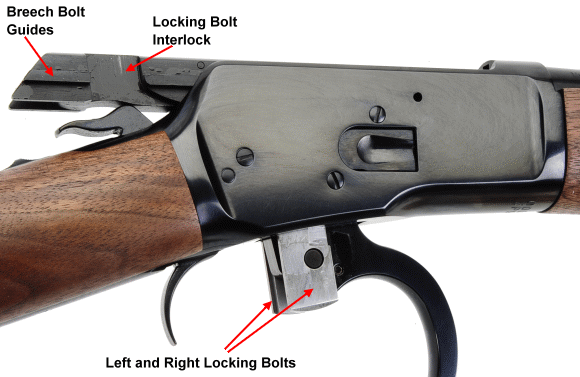
The Model 1892 is based on an existing robust design. A scaled down version of the Winchester Model 1886 long action, The Model 1892 has the same dual vertical locking bolts that key into the breech bolt when the lever is closed and breech bolt guides closely locate the breech bolt to the receiver. The breech bolt is secured longitudinally, vertically and horizontally.
Modern Model 1892 innovations
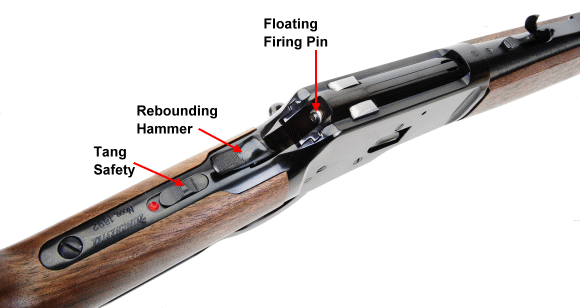
The modern Model 1892 has a two position tang safety, “Fire” and “Safe”. In the “Safe” position the hammer will still fall from the cocked position, however, the safety blocks the firing pin and prevents contact with the hammer. The firing pin floats and the hammer rebounds to a position away from the firing pin after the rifle has been fired and the trigger returns to the forward position. The original version of the firearm only had a half cock hammer position as a safety device when a round was chambered. The modern system is safer, particularly in safeguarding against an accidental discharge in the event of a dropped firearm.
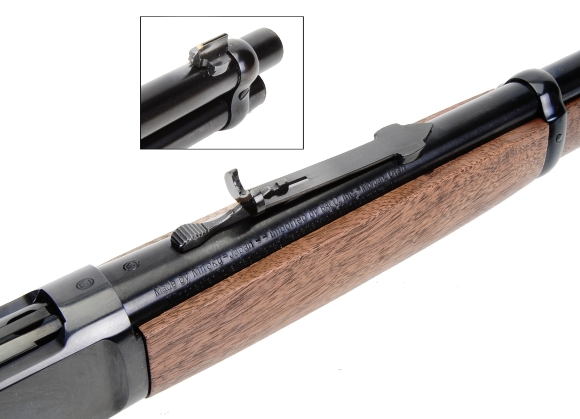
The rear sight is an elevator adjustable semi buckhorn type that can be drifted for windage compensation. The front sight is a Marble Arms® Gold Bead type that is dovetail mounted. Good sights for this type of rifle in a woodland environment. The receiver is also drilled and tapped for a peep sight or side mounting a scope for more critical or distant shooting.
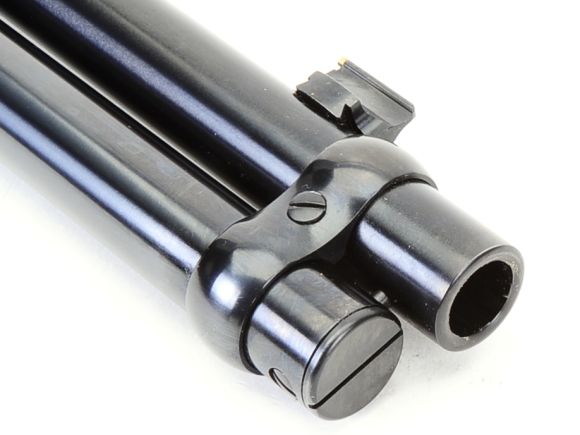
Difficult to hide the caliber. While the original Winchester Model 1892 had many barrel and magazine length options over the duration of its run, the current carbine is available only with a 20″ barrel and full length, ten shot magazine. This is a good combination, particularly with modern 45 Colt ammunition.
The 45 Colt as a flexible cartridge
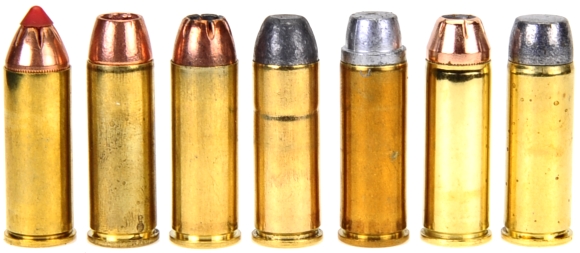
Pictured above, six factory loads and one handload for the 45 Colt. Represented types and weights runs from the Hornady 225 grain LeverEvolution with soft tip FTX bullet to the Grizzly 265 grain flat nose hard cast. There are currently fifty four factory loads available for the 45 Colt in standard and +P pressure levels in bullet weights from 157 grains to 360 grains. Winchester approves use of only standard pressure ammunition, however, +P ammunition manufacturers universally list the modern Winchester Model 1892 as a suitable forearm. Why the difference of opinion? There is no SAAMI 45 Colt +P ammunition standard so the pressure levels are determined independently by the ammunition manufacturers. If Winchester approved use of +P ammunition, they would be signing up to the use of undefined, nonstandard ammunition.
Handloaders have access to many types of bullets, one hundred thirteen at this time, also in many types of construction and in weights from 170 grains to 360 grains. Load levels in magazines run from standard pressure 45 Colt to +P pressures for listed firearms, including the Winchester Model 1892. Winchester approves only the use of factory ammunition.
| Cartridge | Bullet Grains |
Listed FPS 5.6″ BBL |
Recorded FPS 20″ BBL |
Energy Ft. Lbs |
| Hornady FTX | 225 | 960 | 1099 | 604 |
| Corbon DPX +P | 225 | 1200 | 1579 | 1246 |
| Remington HTP | 230 | 850 | 1078 | 594 |
| MagTech CAS | 250 | 761 | 990 | 544 |
| Hard Cast Handload +P |
255 | 1346 | 1686 | 1610 |
| Buffalo Bore Heavy Colt +P | 260 | 1450 | 1953 | 2203 |
| Grizzly Big Bore | 265 | 1400 | 1589 | 1486 |
It becomes obvious that even the short 20″ carbine can generate significantly greater power than a 5″ or 6″ barrel revolver and +P loads turn the little Winchester into a different type of rifle. In fact, the Buffalo Bore load out performs the 170 grain 30-30 WCF cartridge in a similar firearm.
The 45 Colt doesn’t lose much of an edge at a typical woodland hunting distance. As an example, with a +3″ ordinate, the Buffalo Bore load is point blank at 159 yards. At 200 yards, drop is approximate 7″ which is not a difficult hold over and 900 ft lbs of energy is more than sufficient to drop a deer.
There may be a more in the 45 Colt. The Hornady’s 225 FTX bullet has a better ballistic coefficient than the jacketed hollow point used in the Buffalo Bore cartridge and the Hornady shank is short enough to preserve reasonable case capacity. Velocity can be cranked up significantly over factory ammo, but the bullet is too fragile for this type of application.
Conclusions
My favorite loads for the Winchester Model 1892 were the Buffalo Bore and my own hard cast handloads. Both provided plenty of power and both shot under 1 1/2″ at 50 yards with open sights from a sled with my eyesight limitations. I also enjoyed shooting the MagTech light CAS loads.
A good deal of ammo went through the Winchester and without complaint. I routinely loaded mixed bullet types and weights in its magazine and it never hesitated feeding, firing or ejecting. The 1892 is a fast pointing rifle, which makes it ideal for Maine woodland hunting where opportunities come and go quickly. The front sight brass bead is easy to see against trees or looking out over large clearings and fields.
The subject rifle was received with precise fit of parts, metal and wood, and the same conditions remained when the project was completed. Metal pieces are deeply blued and cleanly finished. The walnut stocks have the believable appearance of an oil finish and the grain has lots of personality. Some may feel the Winchester Model 1892 is a little pricey, but it is a lot of rifle for the money and one would last a life time.


Email Notification